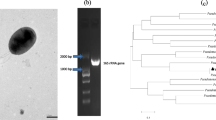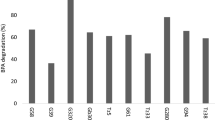Abstract
Because limes have been used as important fertilizers to neutralize acidified farmland in Japan, our interest in this study was focused on the effect of calcium ion on the biodegradation of octylphenol polyethoxylates (OPEOn) by a pure culture of Pseudomonas putida S5 isolated from a rice paddy field in Japan. In the presence of calcium ion, P. putida S5 accelerated the formation of octylphenol oligoethoxy carboxylates (OPECn) rather than that of octylphenol oligoethoxylates under an aerobic condition, indicating that more soluble biodegradates with terminal carboxyl group may liquate out easily to surface and ground water rather than more hydrophobic biodegradates with shorter ethylene oxide residues. Therefore, the androgen receptor (AR) activity of their degradation products was characterized using an in vitro reporter gene assay. As ethylene oxide chain length decreased, the biodegradates, OPEOn (n < 3), increased their AR antagonist activity. However, OPECn (n < 3) were unable to determine their AR activity because of their cytotoxicity in our reporter gene assay system.




Similar content being viewed by others
References
Ahel M, Giger W, Koch M (1994a) Behaviour of alkylphenol polyethoxylate surfactants in the aquatic environment. 1. Occurrence and transformation in sewage treatment. Water Res 28:1131–1142
Ahel M, Giger W, Schaffner C (1994b) Behaviour of alkylphenol polyethoxylate surfactants in the aquatic environment-II. Occurrence and transformation in rivers. Water Res 28:1143–1152
Ahel M, Schaffner C, Giger W (1996) Behaviour of alkylphenol polyethoxylate surfactants in the aquatic environment-III. Occurrence and elimination of their persistent metabolites during infiltration of river water to groundwater. Water Res 30:37–46
Field JA, Reed, RL (1996) Nonylphenol polyethoxy carboxylate metabolites of nonionic surfactants in U.S. paper mill effluents, municipal sewage treatment plant effluents, and river waters. Environ Sci Technol 30:3544–3550
Gejlsbjerg B, Klinge C, Petersen LS, Madsen T (2001) Toxicity of linear alkylbenzene sulfonates and nonylphenol in sludge-amended soil. Environ Toxicol Chem 20:2709–2716
Itoh S, Kawakami H, Fukuzumi S (1998) Electrochemical behavior and characterization of semiquinone radical anion species of coenzyme PQQ in aprotic organic media. J Am Chem Soc 120:7271–7277
Jobling SJ, Sumpter JP (1993) Detergent components in sewage effluent are weakly oestrogenic to fish: An in vitro study using rainbow trout (Oncorhynchus mykiss) hepatocytes. Aquat Toxicol 27:361–372
Knoche M, Bukovac MJ (1993) Studies on octylphenoxy surfactants. XI: Effect on NAA diffusion through the isolated tomato fruit cuticular membrane. Pestic Sci 38:211–217
Nishio E, Ichiki Y, Tamura H, Morita S, Watanabe K, Yoshikawa H (2002) Isolation of bacterial strains that produce the endocrine disruptor, octylphenol diethoxylates, in paddy fields. Biosci Biotechnol Biochem 66:1792–1798
Nishio E, Yoshikawa H, Wakayama M, Tamura H, Morita S, Tomita Y (2005) Isolation and identification of Sphingomonas sp. that yields tert-octylphenol monoethoxylate under aerobic conditions. Biosci. Biotechnol. Biochem 69:1226–1231
Quiros L, Cespedes R., Lacorte S, Viana P, Raldua D, Barcelo D, Pina B (2005) Detection and evaluation of endocrine-disruption activity in water samples from Portuguese rivers. Environ Toxicol Chem 24:389–395
Renner R (1997) European bans on surfactant trigger transatlantic debate. Environ. Sci Technol 31:316A–320A
Sato H, Shibata A, Wang Y, Yoshikawa H, Tamura H (2001) Characterization of biodegradation intermediates of non-ionic surfactants by matrix laser desorption/ionization-mass spectrometry. 1. Bacterial biodegradation of octylphenol polyethoxylate under aerobic conditions. Polym Degrad Stab 74:69–75
Sato H, Shibata A, WangY, Yoshikawa H, Tamura H (2003) Characterization of biodegradation intermediates of nonionic surfactants by MALDI-MS. 2. Oxidative biodegradation profiles of uniform octylphenol polyethoxylate in 18O-labeled water. Biomacromolecules 4:46–51
Soto AM, Justicia H, Wray JW, Sonnenschein C (1991) p-Nonyl-phenol: an estrogenic xenobiotic released from “modified” polystyrene. Environ Health Perspect 92:167–173
Stevens PJG, Bukovac MJ (1987) Studies on octylphenoxy surfactants. I: Effects of oxyethylene content on pocoperties of potential relevance to foliar absorption. Pestic Sci 20:19–35
Tamura H, Knoche M, Bukovac MJ (2001) Evidence for surfactant solubilization of plant epicuticular wax. J Agric Food Chem 49:1809–1816
Tasaki Y, Yoshikawa H, Tamura H (2006) Isolation and characterization of an alcohol dehydrogenase gene from the pctylphenol polyethoxylate degrader Pseudomonas putida S-5. Biosci Biotechnol Biochem 70:1855–1863
White R, Jobling S, Hoare SA, Sumpter JP, Parker MG (1994) Environmentally persistent alkylphenolic compounds are estrogenic. Endocrinology 135:175–182
Yang K, Zhu L, Xing B (2006) Enhanced soil washing of phenanthrene by mixed solutions of TX100 and SDBS. Environ Sci Technol 40:4274–4280
Ying GG, Williams B, Kookana R (2002) Fate, behavior and effects of surfactants and their degradation products in the environment. Environment Int 28:215–226
Yuan SY, Yu CH, Chang BV (2004) Biodegradation of nonylphenol in river sediment. Environmental Pollut 127:425–430
Acknowledgement
This work was supported in part by the Agricultural High-Tech Research Center, Meijo University and a Grant-in-Aid from the Ministry of Agriculture, Forestry and Fisheries of Japan.
Author information
Authors and Affiliations
Corresponding author
Rights and permissions
About this article
Cite this article
Shibata, A., Ishimoto, Y., Nishizaki, Y. et al. The effect of calcium ion on the biodegradation of octylphenol polyethoxylates, and the antiandrogenic activity of their biodegradates. Appl Microbiol Biotechnol 77, 195–201 (2007). https://doi.org/10.1007/s00253-007-1138-y
Received:
Revised:
Accepted:
Published:
Issue Date:
DOI: https://doi.org/10.1007/s00253-007-1138-y




